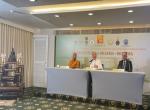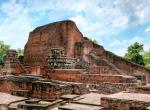Though he often lamented the extent and depth of Indian influence on Chinese civilisation in the past, Ambassador Hu Shih (1891-1962) scholar-formidable of China’s cultural renaissance nevertheless conceded India’s immense contribution to his country’s cultural and civilisational development in a paper entitled ‘East and West: The Indianization of China: A Case Study in Cultural Borrowing’ presented at the Harvard Tercenary Conference of Arts and Science. Speaking in superlatives, Hu observed that ‘India conquered and dominated China culturally for two thousand years without ever having to send a single soldier across the border. …Never before had China seen a religion so rich in imagery, so beautiful and captivating in ritualism and so bold in cosmological and metaphysical speculations. [And] Like a poor beggar suddenly halting before a magnificent storehouse of precious stones of dazzling brilliancy and splendour, China was overwhelmed, baffled and overjoyed. She begged and borrowed freely from this munificent giver. The first borrowings were chiefly from the religious life of India, in which China’s indebtedness to India can never be fully told.’
In fact the introduction of Buddhism in China has always been considered as one of the most important events in Chinese history. Since its inception into that country Buddhism continued to be a ‘major factor in Chinese civilisation, exercising a great influence on religion, philosophy, art, and literature.’ And at least in the past some Chinese have freely and gratefully acknowledged this cultural-civilisational debt by referring to India as the ‘Teacher of China’ and the Chinese Buddhist had always pictured her as a ‘Western Paradise, Sukhavati.’ Of late the ‘pupil’ has begun overshadowing the ‘teacher’ in matters cultural while the ‘teacher’ appears to be systematically losing her past historical memory and abdicating her civilisational space and getting progressively dependent on other powers to formulate and implement projects that define her civilisational identity. At least that is what appears from China’s recent move in monopolizing the development of the birthplace of the Buddha at Lumbini in Southern Nepal, steam rolling issues of national sovereignty and regional religious sensitivities. It is a clear indication that ‘soft-power has now entered China’s official language’ and that cultural diplomacy has indeed begun to play an increasingly important role in its scheme of things. The wielding of cultural power has in fact always been an important objective for the Chinese who see the use of economic power alone as having ‘severe limitations’ and of being incapable of giving it a larger standing in the comity of nations. Interestingly in the ancient world there appears to have been no dichotomy between commerce and philosophy. Buddhists legends apparently teem with stories of Indian and Chinese ‘merchants reputedly capable of discussing metaphysical questions.’ For them philosophy and trade were not ‘supposed to be incompatible.’ The Chinese, it seems have preserved this sense from the past and have begun to dexterously and effectively combine the twin diplomacies of commerce and philosophy (read culture) in the present.
The China based Asia Pacific Exchange and Cooperation Foundation’s (APECF) ostensible purpose in investing $3billion to build a ‘special development zone’ in Nepal by transforming the town of Lumbini into a mega tourist, pilgrim and education centre was to evolve a ‘strategic centre-point for promoting Buddhist culture.’ This was stated by APECF Vice-Chairman and a senior CPC leader Xiao Wunan who hoped that the project, which received the backing of the Chinese government at the highest levels, would also unite all three strands of Buddhism including the Tibetan. For a country that had unleashed an all-out war against Buddhism as part of its cultural revolution in the 60s of the last century, had imposed a ‘revisionist version of Buddhism’ on its adherents and had by 1959 destroyed as many as 6,000 Buddhist monasteries in Tibet alone and shipped most of their rare artifacts for melting in giant foundries in the mainland, this rather new found interest in developing the Sakyamuni’s birthplace is cause for concern. The national security angles to the project cannot be understated, it has been pointed out that Lumbini is a mere two hour drive from India’s Gorakhpur and the project – if given the go ahead which for the time being looks to be stymied with the Nepal Cultural Ministry taking exception at not being consulted by the UNIDO and APECF– would in effect bring the Chinese across the Himalayas right up to the ‘lower foothills bordering India.’ The other cause for concern is that one of the Vice-Chairman of APECF is the Maoist leader Prachanda and one of its other members is the controversy-courting prince Paras. The other unstated fall-out of the project and one which is bound to be worrisome for the Indian security establishment is that a majority of the project contracts would be awarded to Chinese companies and pave the way for the entry of ‘PLA-affiliated sub-contractors’ and engineers ensuring a long term Chinese presence in the area bordering India.
On the religious side the move appears to be made with the aim of neutralizing the Dalai Lama’s influence by encircling one of the most sacred and emotive Buddhist pilgrim spots in the world. Ever since 2006, when the CPC proactively attempted to rehabilitate Buddhism, such overtures have been periodically made. The interest the Chinese have evinced in the upcoming Nalanda University in Bihar is a recent case in point. But the ironies of history require periodic reiteration, at least for the purpose of preserving these in the collective civilisational memory. For example it would be instructive to recall that despite its magnificent contribution to the evolution of Chinese civilisation Buddhism and its adherents in China have historically faced persecution and suppression. This newfound concern of the Chinese, therefore, for preserving the Buddha’s birthplace seems to smack of rank opportunism. The ‘Fen-shu-keng-ju’ ‘incident in which scholars were buried alive and books burnt occurred during the reign of the first Chin monarch and builder of the Great Wall, Shih Huang-ti (246-210 BCE). The reign of emperor Wu the ‘Warlike’ between 424 and 452 C.E. saw more prosecutions and attacks on Buddhists. Wu, it is believed, was the first sovereign to really ‘lay violent hands upon Buddhism’ when he decreed ‘that the monks should be put to death, and the Buddhist images should be burned or smashed’ and that ‘everyone who concealed a monk should be put to death, together with his whole family.’ Some of the decrees of that period enjoined upon the governors of the provinces to demolish or burn all Buddhist places of worship and to ‘throw down the precipices all monks, young or old’ who dared to follow the religion. Officials during the seventh century Tang dynasty questioned the need for the Buddhist religion and denounced the clergy as a ‘class of useless drones, idlers, and beggars,’ whose ‘religious work encourages waste of money, especially spent in the erection of temples and monasteries.’ Fù-Yi’s ‘Memorial against Buddhism’ made during this period and which saw wide circulation discussed the ‘fell effects of Buddhism in times past’ and proposed to altogether do away with the religion. In that sense, there have been in the China of the past several precursors to its twentieth century ‘cultural revolution’, all of them with strikingly similar manifestations and expressions!
Losing civilisational memory incapacitates a civilisation to defend or preserve its cultural space. India’s civilisational links with Lumbini extend over eons and yet its memory appears incapable of moving us towards displaying an active interest in the area’s well being and growth. We appear to be losing it amidst the mist of centuries. When Emperor Asoka was ‘engaged in humanizing politics by incorporating the spirit of Buddha’s compassion into his administration’ China was just beginning to emerge as a unified state after a period of chaos, civil strife and conflict. In the twentieth year [249-250 BCE] of his reign the mighty emperor ‘visited in person the place where the Buddha was born and did worship there.’ It is said that the venerable Buddhist monk Upagupta who guided the emperor to the sacred grove – Lumbini Vana – addressed Asoka thus, ‘asmin Mahārāja pradeśe Bhagavān jātah’ (‘In this place, O great king, the Blessed One was born’) To commemorate the event of the Divine birth, Asoka installed a pillar of stone, constructed stupas and made the village of Lummini (Lumbini) free of religious cesses’ and reduced its payment of other shares. The commemorative pillar edict records the pilgrimage of the Indian emperor, ‘By His Sacred and Gracious Majesty the King when he had been consecrated twenty years, having come in person and reverence having been done – inasmuch as “Here was born Buddha, the sage of the Sâkyas” – a stone bearing a horse was caused to be made and a stone pillar was erected.’ Historian Radhakumud Mookerjee, one of the earliest nationalist chroniclers of Asoka and his empire visited the area in 1927 and described the place thus, ‘…I rode through the village of Padaria to the site of the Asokan Pillar about two miles distant…Within a few paces of the pillar stands a temple enshrining an ancient sculpture representing the Nativity of the Buddha, the figure of his mother Mahāmāyā, standing under the sāl tree after her delivery with three attendants.’ We seem to consign all of these into oblivion and to miss the symbolism of the fact that one whose reign became one of the defining periods of Indian civilisation chose to humbly commemorate the twentieth year of his reign at the sacred Lumbini.
While Asoka’s legacy was rediscovered, rescued and reintegrated into the mainstream of our national life, the significance, symbolism and uniting potential of this spot of Lumbini appears to have been ignored and remains obfuscated. India could have at least facilitated the implementation of a master plan drawn up by the leading Japanese architect Kenzo Tange (1913-2005) way back in 1978 on invitation from the Nepal government. The plan, which has since been gathering dust due to paucity of resources and facilitation, was to be implemented within seven years and proposed to involve other nations with significant Buddhist population such as Sri Lanka, Japan, Myanmar, South Korea, and Thailand apart from China. The facilitation of that plan would have perhaps been more in keeping with the spirit and message of Buddhism. Instead of making the whole project the sole show of a particular government through proxy foundations, the effort should have been instead to try and create a consortium of all nations with a strong Buddhist link, including the Tibetans and under the leadership of Nepal and the UNESCO - which has declared Lumbini as a world heritage site – to jointly develop the area and consecrate it to humanity as whole with the message of freedom, peace and progress. India – being the cradle of Buddhism - should have extended a generous and munificent hand of assistance and not let the original plan, with its far greater aesthetic appeal, languish and fall by the way side. She could have, long back, initiated projects to transform her border districts with Nepal into a special cultural and religious zone. It might also be worth remembering that this entire zone once teemed with vibrant and robust self-governing republics. With the Nepal government rejecting last week the project saying that ‘it would not entertain any deal struck in a third country without the participation of the actual stakeholders’ the possibilities of renewing the original Kenzo master-plan can still be discussed and other nations be immediately invited to be part of what can be turned into a truly international project. India may unconditionally make her contribution towards re-initiating such an effort and thereby prevent the encircling of the ‘Light of Asia’. Had not the ‘Exalted One’ in his last sermon, directed the faithful to, ‘…be ye lamps unto yourselves. [And to] Betake yourself to no external refuge.’?
It was a millennial faith reposed in the Indian civilisation and on its capacity to tirelessly and selflessly irradiate its ways of life and thought.
Sources
- Bhandarkar D.R., Asoka, ( Calcutta: University of Calcutta, 1925)
- Coomaraswamy Ananda, Buddha and the Gospel of Buddhism, (New York: G.P.Putnam’s Sons, 1916).
- Danino Michel, Indian Culture & India’s Future, (New Delhi: D.K.Printworld, 2011).
- Degroot J.J.M, Sectarianism & Religious Persecution in China – a Page in the History of Religion, vol. 1-2, (Amsterdam: Royal Academy of Sciences, 1903-1904).
- Degroot J.J.M., The Religion of the Chinese, (New York: Macmillan Company, 1910).
- Mookerjee Radhakumud, Asoka, (1928), (Delhi: Motilal Banarsidass, rpt.2007)
- Singhal D.P., India and World Civilization, vol.1, (London: Sidgwick & Jackson, 1972).
- Smith Vincent, Asoka: The Buddhist Emperor of India, (Oxford: Clarendon Press, 3rd rev. ed., 1919).
News Report/Analysis
- Alastair Lawson, ‘Slow delivery for Buddha Birthplace project’ BBC News, 10th May, 1999, at: http://news.bbc.co.uk/2/hi/south_asia/340402.stm accessed on 29th July, 2011)
- Joseph Nye, ‘The Olympics and Chinese Soft Power’, Huffpost Politics, 24th August, 2008 at: http://www.huffingtonpost.com/joseph-nye/the-olympics-and-chinese_b_120909.html (accessed on 30th July, 2011).
- Chen Xuegen, ‘Cultural Diplomacy will complement China’s Power’, China View, 17th October, 2009, at: http://news.xinhuanet.com/english/2009-10/17/content_12253669.htm accessed on 30th July, 2011)
- Dean Nelson, Peter Foster, ‘Nepal to build £1.9bn ‘Buddhist Mecca’’, The Telegraph, 17th June 2011.
- Jayadeva Ranade , ‘China strengthens hold on Nepal, comes to India’s doorstep’, Daily News & Analysis, 24th June, 2011.
- Ananth Krishnan, Prashant Jha, ‘Chinese foundation plans $3 billion project in Nepal’, The Hindu, 17th July, 2011.
- Kosh.R. Koirala, ‘UNIDO, APECF sign memorandum for the development of Lumbini’, Asian Tribune, 18th July, 2011.
- C.Rajamohan, ‘Losing Lumbini’, The Indian Express, 20th July, 2011.
- ‘Nepal rejects ambitious Chinese Buddhist venture’, The Times of India, 28th July, 2011.
- P.Parameswaran, ‘Marxists as museum pieces’, The New Indian Express, 1st August, 2011 at: http://expressbuzz.com/opinion/op-ed/marxists-as-museum-pieces/299140.html (accessed on 1st August 2011).
------------------------------------------
Published Date: 8th August, 2011










Post new comment